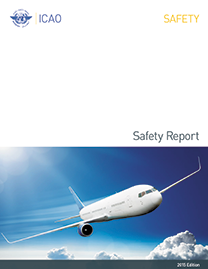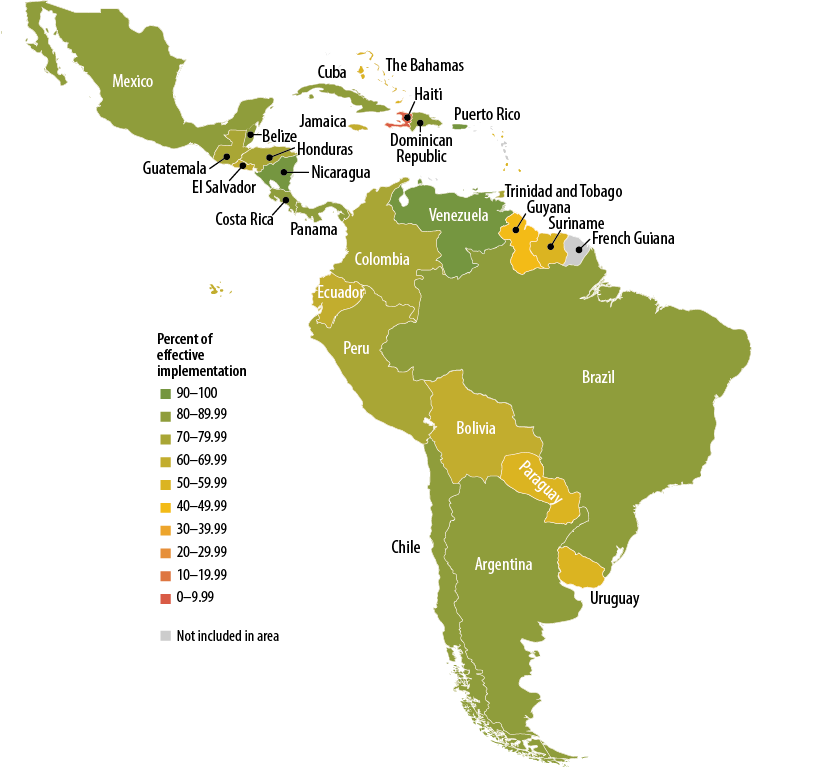
Almost as soon as the International Civil Aviation Organization (ICAO) established a new common framework in the mid-2000s for states and commercial air transport entities to coordinate safety policies and initiatives, one area of the world began moving to the forefront in executing the planning methodology and demonstrating world-class best practices.
The six-year experience of the Regional Aviation Safety Group–Pan America (RASG-PA) has validated several aspects of applying ICAO’s framework to make air travel safer over time, according to documents and data published on the ICAO website. State governments, commercial air carriers, air navigation service providers, pilot associations and other stakeholders have worked closely to transform themselves into early adopters of advanced systems, a model of how to prioritize long-term efforts and a success in focusing resources on the latest techniques of safety data analysis.
Recalling when RASG-PA was formed in November 2008, ICAO later called the group “the first initiative in civil aviation designed to address the gaps between air navigation and operational safety implementation activities. … RASG-PA will serve as a focal point to ensure harmonization and coordination of safety efforts aimed at reducing aviation hazards and risks in North America, Central America, the Caribbean and South America.”1 Some participants expected at the outset that ICAO’s framework would help them build a fair and effective safety reporting culture and improve civil-military cooperation in aviation safety.
At the group’s first meeting, Günther Matschnigg, then senior vice president, safety, operations and infrastructure, International Air Transport Association (IATA), told attendees, “In 2008, the Pan American accident rate climbed to 2.55 accidents per million sectors flown, compared to 1.61 accidents in 2007. This is a serious concern and it demonstrates, in part, why the new RASG-PA initiatives and strategy need to begin to take effect quickly.”
ICAO also cited group aspirations described by Gerardo Hueto, now chief engineer, aviation system safety, Boeing, and a member of its steering committee, who said, “We view the RASG-PA as an agent that can anticipate problems and opportunities that may arise, as well as promote important cross-sharing of safety best practices and data.”
RASG-PA established at its beginning, and has continued, three working groups: a regional aviation safety team–Pan America, an aviation safety training team and an annual safety report team.
At the next year’s meeting, RASG‑PA’s leaders held discussions on the possibility of benefiting quickly from existing research and development. Specifically, ICAO said they “investigated how to incorporate several [U.S.] Commercial Aviation Safety Team (CAST) initiatives [i.e., safety enhancements] and [to develop] tools for Pan American states that would provide them with the necessary legal framework to ensure the protection of safety information and therefore the enhanced ability to assess aviation system safety.”
 The launch of RASG-PA quickly led to publication of the world’s first annual safety report by an ICAO RASG. The report was promoted as “a timely, unbiased and transparent source of safety-related information essential for all aviation stakeholders interested in having a tool to enable sound decision making on safety-related matters.” The first-year prototype had been a simple working paper, but it led to cooperation by adding comprehensive analyses of regional data from Boeing Commercial Airplanes, ICAO and IATA. The annual safety report team has continued to produce the report, and its analyses and other content have been reflected in ICAO’s global annual reports.
The launch of RASG-PA quickly led to publication of the world’s first annual safety report by an ICAO RASG. The report was promoted as “a timely, unbiased and transparent source of safety-related information essential for all aviation stakeholders interested in having a tool to enable sound decision making on safety-related matters.” The first-year prototype had been a simple working paper, but it led to cooperation by adding comprehensive analyses of regional data from Boeing Commercial Airplanes, ICAO and IATA. The annual safety report team has continued to produce the report, and its analyses and other content have been reflected in ICAO’s global annual reports.
Global Context
ICAO’s latest master plan for worldwide improvements2 says, “With air traffic projected to double in the next 15 years, current and emerging safety risks must be addressed proactively to ensure that this significant capacity expansion is carefully managed and supported through strategic regulatory and infrastructure developments. It is therefore imperative that states and regions remain focused on establishing, updating and addressing their safety priorities as they continue to encourage expansion of their air transport sectors. [The Global Aviation Safety Plan 2014-2016 (GASP)] provides a familiar planning framework to assist states and regions to make improvements in safety through the use of the four safety performance enablers: standardization, collaboration, resources and safety information exchange. … It is particularly vital that all states put in place, over the next decade, effective safety oversight systems (including proper governance arrangements) and fully implement the ICAO State Safety Programme (SSP) framework.”
The first ICAO Journal of 2015 reported that the organization’s High Level Safety Conference in February “delivered clear affirmations for the objectives now being pursued in every world region under the [GASP]. … Coordinating and supporting the regional implementation of the GASP has been entrusted to the RASGs, which have been established by ICAO in all regions.”3
The work of RASG-PA, as well as that of other RASGs, is conducted in the context of expectations that all countries will implement an effective safety oversight system by 2017, and in that near-term time frame, will complete their introduction of technology, infrastructure and procedures for performance-based navigation (PBN). “[PBN] enhances safety by addressing a number of risks, including those associated with [controlled flight into terrain (CFIT)], runway excursions and the loss of aircraft separation,” the master plan says. Among their affirmations in the Montreal Declaration of 2015, ICAO member states committed to “expedite full implementation of [PBN] regulatory oversight.”
By “effective oversight system,” ICAO means adopting its standards and recommended practices (SARPs) for every state’s approval, authorization, certification and licensing processes. A high priority in doing this is providing adequate resources — including legal, regulatory and organizational structures — to effectively perform universal state safety oversight obligations through a robust state safety program.
“[RASGs’] annual safety reports … provide regular updates on the level of progress achieved with respect to the [global] objectives through measurement of reactive, proactive and predictive safety indicators,” ICAO said. RASG-PA has focused and prioritized actions to improve runway safety, reduce CFIT accidents and reduce loss of control–in flight (LOC-I) accidents and incidents. As of 2015, RASG-PA has added reduction of risk of midair collisions as a fourth safety priority.4
After RASG-PA’s establishment, ICAO transitioned from conducting state assessments with long intervals for corrective action under its Universal Safety Oversight Audit Programme (USOAP) to the USOAP Continuous Monitoring Approach, designed to provide ongoing website reports of each state’s effective implementation of eight critical elements of safety oversight (Figure 1).
Figure 1 — Effective Implementation of Eight Critical Elements of ICAO USOAP CMA

USOAP = Universal Safety Oversight Audit Programme; CMA = Continuous Monitoring Approach
Note: Software dashboards on the ICAO website enable viewing of safety data from subregions involved in the Regional Aviation Safety Group–Pan America.
“RASGs provide a formal reporting channel to enable monitoring of worldwide [performance-based safety system] implementation. … An added objective of the groups is eliminating the duplication of efforts through the establishment of more cooperative regional safety programmes [— an approach that] significantly lessens the financial and human resource burden on states,” ICAO said.
Early Safety Projects
RASG-PA spearheaded a project called Effective Errors and Incident Reporting, which developed, proposed and, in 2010, distributed to all Pan American states a model legal framework to protect safety information. The project’s participants subsequently worked on this with the ICAO Safety Information Protection Task Force, which involved Flight Safety Foundation.
Another early project called Use of Technology to Enhance Safety sought new ways to leverage the flight operational quality assurance (FOQA) programs of airlines in this region. “The objective is to share information between aircraft operators, air traffic services and state [civil aviation authorities] to facilitate early recognition of risks related to routine operations and how to manage and mitigate those risks,” RASG-PA reported at the time. … Early data suggest a reduction of unstabilized approaches at the project airport [in Costa Rica] (see ‘Sharing Data, Improving Safety,’ p. 21).”
RASG-PA and the Latin American and Caribbean Air Transport Association (ALTA) also introduced the Pan American Aviation Safety Summit, accompanied in 2010 by training focused on risk mitigation related to runway excursions, CFIT and LOC-I.
Each of RASG-PA’s annual safety reports has drawn distinctions between the current and long-term value of data in separate reactive, proactive and predictive sections.
The 2011 report noted that reactive data for “LOC-I and CFIT showed decreasing trends [comparing five-year averages]; meanwhile, system-component failure/malfunction (non-powerplant) … and unknown … occurrences are emerging categories in the region. The monitoring of the behavior of these occurrences should be maintained to determine the impact of mitigation strategies.”
Proactive data that year enabled use of USOAP findings that showed “a high level of lack of effective implementation … of ICAO SARPs in some states of the region. Moreover, qualification and training of the technical staff became the most affected critical element in the region. … Technical personnel qualifications and training … is the top issue affecting the [implementation] percentage.”
Specifically, the region’s average effective implementation for the critical elements of state safety oversight was 65.21 percent. For more than half of member states audited by ICAO, the corresponding values were greater than 70 percent — that is, in a range exceeding ICAO’s 70 percent target.
As for exploiting any predictive safety information, RASG-PA said in 2011 that this region “had not yet fully developed mechanisms for gathering and processing predictive safety information.” Significantly, however, the group pointed to initiatives already under way that would “advance capabilities to produce predictive safety information.”
The 2011 report added, “Accident rates in the [North American–Caribbean] region remained below the world average, but in the [South American] region, the accident rate was 4.196 [accidents per million departures]; higher than the world average (4.137).”

Fast Forward to 2015
Information published in this group’s 2015 annual safety report (referring to 2014 data) — and, as examples, in its summary of a 2014 safety team meeting5 and 2015 plenary meeting6 — provides insights into how far RASG-PA has come through uninterrupted investment of time and resources, and constant focus on agreed priorities.
“The meeting reviewed … [midair collision as] the emerging area of concern based on the trend exhibited by [traffic-alert and collision avoidance system] (TCAS) resolution advisory (RA) data,” the safety meeting summary said, noting also the assignment of the issue to the safety team for safety enhancement initiatives.
RASG-PA also recently set a specific goal for safety metrics. A plenary-meeting presentation by the ICAO Secretariat said that the group’s safety goal now uses 2010 as a baseline reference, and “aims to reduce the operations fatality risk for [air carriers] to 50 percent [of 2010] for 2020 in Latin America and the Caribbean.”
The corresponding RASG-PA risk analysis in part states the baseline (i.e., the five-year-average fatality risk) in 2010 as 0.6 in Latin America and the Caribbean; the RASG-PA goal as a fatality risk of 0.3 in 2020; and the calculated risk reduction due to implementation of its safety enhancement initiatives during 2010–2014 as 25 percent.
“The [2015 plenary] meeting was informed that the [Caribbean] and [South American] Regions face many challenges to improve safety levels; however, both [subregions] have shown progress on safety in the recent years. The meeting agreed that RASG-PA is one of the key contributors of the progress,” the report said.
RASG-PA also was tapped by ICAO to pilot-test in 2014 a method of measuring the institutional strength of civil aviation authorities using a survey instrument.
The plenary meeting also heard a broad description of the latest confidential shared data analyses, which have become routine because of memorandums of understanding among ALTA, the U.S. Federal Aviation Administration’s Aviation Safety Information Analysis and Sharing (ASIAS) program, Boeing, CAST, IATA and RASG-PA.
Far advanced from the 2011 annual safety report, the 2015 report says the group now monitors the following accident/incident precursors using routine flight data monitoring and other sources: runway excursion precursor – unstable approach; CFIT precursor – events related to enhanced ground-proximity warning systems; and midair collision precursor – TCAS RA.
Also in contrast with the 2011 report, the following excerpts from the 2015 report indicate areas of progress: “The number of fatal accidents in 2013 in the Pan American Region for scheduled commercial air transport operations involving aircraft with maximum takeoff mass above 5,700 kg [12,566 lb] was higher than the previous year but slightly below the latest 10-year moving average (2003–2012). Nevertheless, the number of total accidents and total fatalities remained below the mentioned moving average.
“Notably, LOC-I, CFIT and [runway excursion] occurrences showed decreasing trends, especially at the end of the period; however, they continue to represent the highest fatality risk type of accidents, while midair collision … is an emerging category in the Pan American Region, according to this analysis. Precursors of [runway excursions] and CFITs, identified through the analysis of predictive safety data, show decreasing trends. By contrast, TCAS RA events, identified as a precursor of [midair collision] occurrences, is showing an increasing trend in the Pan American Region.
“The proactive safety data used in this report, extracted from the results of the [USOAP], showed 11 states in the Pan American Region that maintain low levels of effective implementation of ICAO SARPs. Moreover, lack of effective technical staff qualification and training continues to be the most significantly affected USOAP critical element … in the region. Of particular significance, the technical areas showing lowest levels of effective implementation were air navigation services … aerodromes and ground aids … and accident and incident investigation. Improvements in these areas should have priority in the [Caribbean subregion] and [South American subregion] due to the continuous growth of commercial air transport operations being forecast. …
“The average effective implementation [of critical elements of state safety oversight] in the Pan American Region … increased from 65.2 percent in 2010 to 69.18 percent as of February 2015. This was mainly due to improvement … achieved by the states audited since 2010. According to ICAO, states [in 2015] should target their efforts to increase and maintain effective implementation above 60 percent.”
Some of the most advanced predictive metrics and analyses available to RASG-PA come from the agreements involving the ASIAS program and IATA. So far, U.S. airlines have contributed de-identified data from their flights to/from specific non-U.S. airports within the Pan American Region.
The 2015 annual safety report said, “ASIAS analysis was conducted using [three years of flight data] provided by … 30 North American airlines that included operations in aerodromes with the following criteria: at least two airlines, each operating with 360 flights or greater; runways with at least 95 percent [usage]; and airplane fleet groups of three or more airlines operating in the [Caribbean] and [South American] Regions. … IATA provided Flight Data eXchange (FDX) data, to show 2013 [Latin American and Caribbean] regional trends of some of the top accident categories’ precursors from Latin American and Caribbean airlines.”
In summary, RASG-PA has evolved in a relatively few years from being able to utilize mainly reactive safety data and proactive ICAO audits in 2009 — with limited or no data about precursors within airlines’ or states’ systems — to routinely working in 2015 with predictive data that set the stage for extensive use of state or subregion sources.
Notes
- ICAO. Regional Report: The Americas. 2010. RASG-PA. Annual Safety Report, Second Edition. September 2011.
- ICAO. 2014–2016 Global Aviation Safety Plan. 2013.
- ICAO. “High-Level Safety Event Takes Urgent Action While Respecting Strategic Goals.” ICAO Journal, Issue 1, 2015.
- RASG-PA. Annual Safety Report, Fifth Edition. May 2015.
- RASG-PA. Summary of Discussions: Sixth RASG-PA Aviation Safety Team Meeting. Dec. 16–17, 2014.
- RASG-PA. Final Report: Eighth RASG-PA Annual Plenary Meeting. Medellín Colombia, June 25, 2015.
Featured image: composite, Susan Reed; flags, Wikimedia; map, Cocoloi | Wikimedia CC-BY-SA 3.0
Airport scene: © FF MM | Wikimedia CC-BY-SA 3.0


